
By Eric Ortiz, executive editor, Community Based News Room
Chaumtoli Huq, editor and founder, Law@theMargins
Elbert Garcia, senior interactive producer, Law@theMargins
[dropcap]J[/dropcap]ournalists and lawyers seek stories for different purposes. For journalists, stories inform and raise awareness of an issue. For lawyers, stories convince judges, juries and other decision makers to change lives.
What unites these two professions at Law@theMargins is our belief that stories—and storytellers—can make social change. The more we can amplify these stories as far and wide as possible, the greater impact the stories can have.
That’s why this week, a group of volunteers including Evrybit founder Eric Ortiz and Law@theMargins’ Chaumtoli Huq and Elbert Garcia, are launching a Community Based News Room (CBNR). Our CBNR is a virtual newsroom of professional journalists and social justice innovators that provides underrepresented people with the narrative and advocacy tools they need to make progressive change in their local communities.
So how did a journalist, digital media technologist and lawyer come together to launch this effort? Like many things in our current world, the action started with a search for survival.
A Common Passion for Storytelling and Social Impact
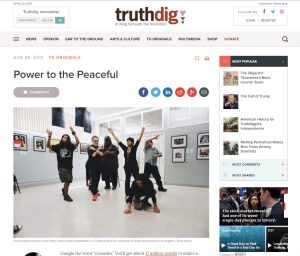
About a year ago, Eric, as the managing editor of Truthdig, set out to write a story on social justice. The story was called “Power to the Peaceful” and began as a profile on Victor Narro, our Law@theMargins board member who is the project director of the UCLA Labor Center and has been fighting for immigrant and labor rights as a Los Angeles organizer for decades. In 2014, Narro wrote a book, “Living Peace: Connecting Your Spirituality With Your Work for Justice,” on how he has been able to integrate themes of spirituality into his social justice work.
“One of the most powerful tools we have today,” Victor shared with Eric, “is the opportunity for people to tell their stories. That’s the only way we’re going to win the debate on issues like immigration.”
Victor’s story led Eric to Chaumtoli and her work with Law@theMargins, which started in 2013 and looks to leverage the power of journalism, legal advocacy and community organizing to transform lives and systems.
“It straddles these different disciplines,” explained Chaumtoli. “Are you a lawyer? Are you a media outfit? What are you? We are all of above.”
This idea of collaboration is an essential strategy—part of a larger toolbox of empowerment—that communities need to realize their own power.
“We need to bring different disciplines together,” continued Chaumtoli. “Listen to each other. Get ourselves outside our professional silos. Then center the story.”
In speaking with the Law@theMargins team, Eric found individuals whose belief in the power of stories mirrored his own. Eric, who developed a mobile storytelling app called Evrybit, had been conducting hands-on storytelling workshops in Los Angeles since 2015, bringing diverse groups of people together and training them how to empower communities by telling stories and creating mobile newsrooms.
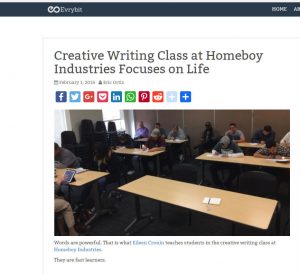
Eric shares a similar mission with Elbert, who helped launch Law@theMargins’ experiment with digital video discussions (webinars) in 2014. As someone who has worked in education, media and government, Elbert knows firsthand how media elements like photos, audio and video can be combined with words to sway policymakers online and offline.
What soon became apparent after several follow-up discussions was how much storytelling is the engine that we all wanted to power our efforts at change.
Organizing Audiences to Receive Important Stories
In a short time, Law@theMargins has shown that our model of combining law and media is effective. For the national sanctuary movement, we hosted a webinar called “Lessons from Organizing for Sanctuary Schools and Colleges” and provided advocacy tools and support. We assembled national experts in education and immigrant rights to train local activists and organizers who wanted to start a sanctuary campaign in their own schools and universities. We produced a resource guide for participants with sample sanctuary policies from various campuses, while the webinar gave participants an overview of the sanctuary movement, the immigration and education law dimensions of the campaign, and examples of organizing for sanctuary at local school boards and campuses.
Furthermore, we advanced an intersectional advocacy framework that promotes educational equity, decreased surveillance of immigrants and Muslims, and stopping the ongoing criminalization of black and Latino youth. We wanted to counter the dangerous narrative we were seeing that divided “deserving” and “undeserving” immigrants, and that failed to connect the immigrant youth movement to the vibrant racial justice movement.
We also wanted to demonstrate to activists that you can, in fact, promote a broader vision for sanctuary movement and stay focused on those most impacted: undocumented students, in this case. This narrative intervention allows immigrant rights activists to build with racial justice advocates.
Our work on sanctuary campus proved that, if done right, connecting on-the-ground advocacy with digital technology and online support can have a powerful effect on changing a narrative.
We have seen similar successes with our #FaithJustice series, which led Eric to interview Victor. Curating content on broad topics under #FaithJustice, we discovered that many local organizers were grappling with burnout and fatigue. Although mainstream articles called for self-care, low-income organizers felt they did not have the luxury to take retreats or spa breaks and “leave their community” to prevent this burnout. Heeding this need, we hosted a highly successful webinar for activists called “Community Care During Times of Political Crisis.”
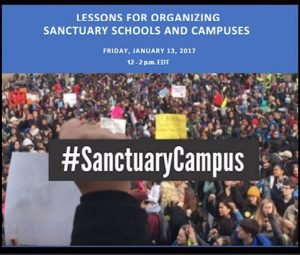
Afterward, we took the salient points from our participants and wrote an op-ed piece that Atlanta Black Star published, along with our video, exposing our webinar to a wider and new audience.
Our unique narrative intervention on community care generated additional media interest from the Los Angeles Times and The Areogram. We curated content that changed the conversation on self-care among activists and then interfaced with larger media to amplify our message.
Helping the Community Reverse Our News Deserts
We had an aha moment. Finding common purpose, we began to think about how to bring stories from underrepresented communities to light, with a focus (to start) on folks impacted by our legal system. We acknowledged the daunting task of telling these stories. How could we succeed when so many news outlets have folded? The risk of these stories being invisible made the effort worth it. Our plan? Start small and invite others to join us as storytellers.
Our CBNR would fill a “news desert” where movements are active but their stories are not being told. In other areas, advocacy resources are scarce. By providing an online platform for social change stories, training activists to share their campaigns, and offering capacity-building advocacy tools, we can empower organizers to foster and lead the change in their communities.
We decided to test the waters. As a volunteer-driven, nonprofit organization with no external funding, we started with what we do best: hosting a webinar and convening similar-minded people. Last October, we ran a webinar on “Empowering Communities through Storytelling and Mobile Journalism. From that webinar, we met Jan Shelly and learned about her work as a retired lawyer with incarcerated women in Florida. Jan, like us, shared a desire to lift up stories that are not being told. In particular, she wanted to tell the stories of women and their families that are experiencing the cruelties of our criminal justice system, including Kathleen Carlin and her daughter Sadie.
We agreed to launch our CBNR. And so began our quest in search of the untold story. Every other week, we plan to feature one of these stories as part of our CBNR.
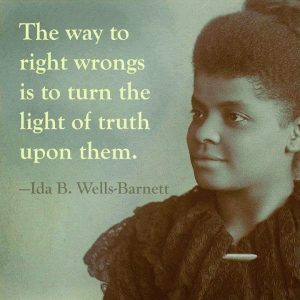 How You Can Help
How You Can Help
This Community Based News Room (CBNR) is built on community and collaboration. Our hope is that you, after reading the stories we publish, will be interested to collaborate with us to help build our CBNR.
We are interested in working with:
*Journalists who are committed to using their craft for social change.
*Media technologists who want to use their knowledge to amplify the voices of untold stories.
*Advocates who want to lift up stories to move people to change.
*Community-based groups fighting for social justice.
*Persons impacted by our legal system and law.
*Any marginalized communities.
We want to help tell stories that need to be told.
As pioneering African-American journalist and anti-lynching crusader Ida B. Wells-Barnett wrote: “The way to right wrongs is to turn the light of truth upon them.”
We want to create a more fair, just world with our Community Based News Room. By bringing untold stories of injustice to light and providing tools and support for underreported advocacy work, we will give a voice to those whose voices often are not heard. Our belief is that this platform can create a circle of compassion that leads to transformative change.
Contact us at editors@staging.lawatthemargins.com to learn more about our CBNR, share a story idea, get involved, offer feedback or just say hi.
We look forward to building a strong community.
One story at a time.
Look for our first CBNR story this Wednesday, April 11. If you have a story to tell or know a story that needs to be told, please contact us here. Our Community Based News Room will help you tell your story.


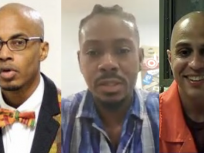


freeramsey.com